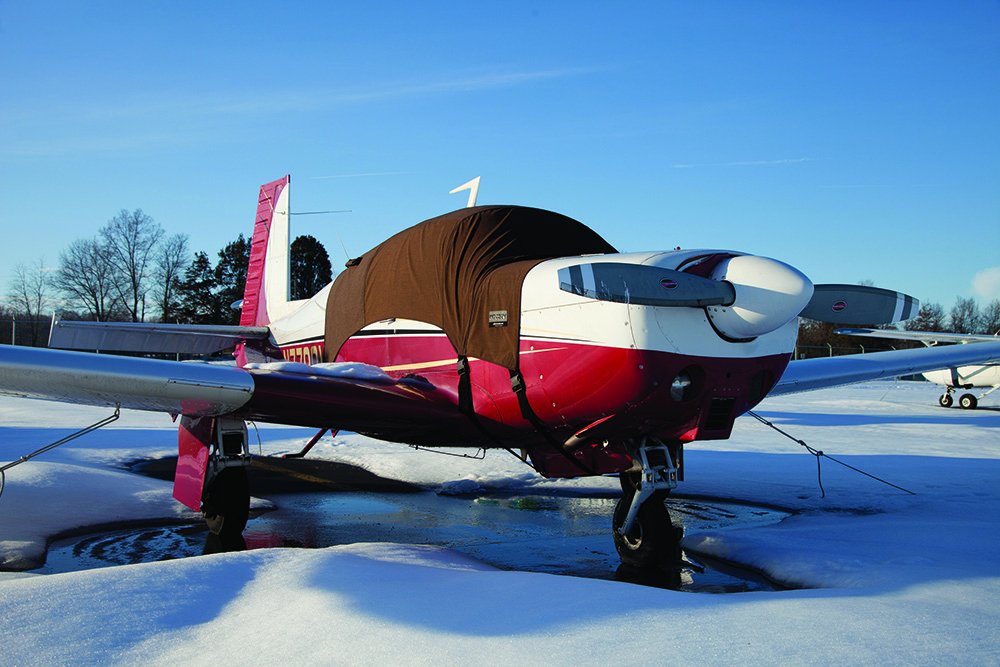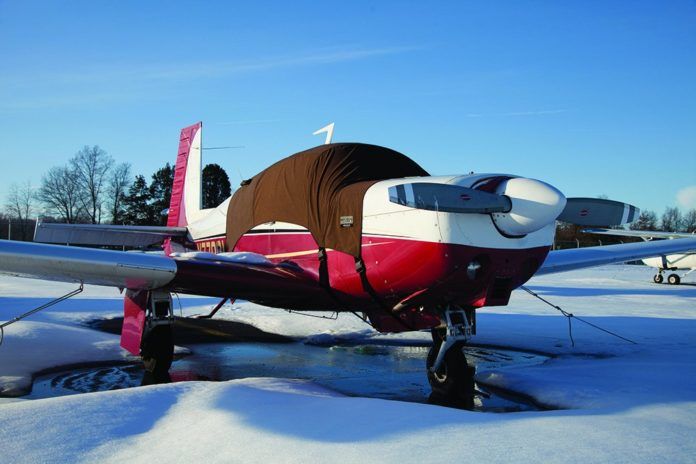For those of us flying IFR in locations with a high probability of a white Christmas each year, we often need to recalibrate our aeronautical mindset from summer. We have to switch our weather default from “Where are the thunderstorms?” to “Where is the ice?” Winter brings us more challenging preflights, engine starts and airport operations. Even though we are all experienced instrument pilots, it’s still worth taking a few minutes to think about cold weather operations as we head into the worst of the season.
Adam Wright
Weather Planning
Flying IFR in winter means seeking out as much information about weather and airport conditions as possible. Winter weather can be complex, with layers of clouds that might contain ice, rapidly changing visibilities and questionable runway conditions tied in with a lot of night flying. It means having a couple of potential alternate airports in mind if a diversion is needed, and that those alternates must be within the aircraft’s range.
Wintertime winds can be very strong—and their intensity can vary greatly with altitude, so paying close attention to winds aloft forecasts and obtaining actual wind information, when available, can make a big difference in your endurance and fuel reserves. It is not unusual to see a change in wind velocity as much as 30 knots at 5000 feet.
Survival Considerations
Experienced pilots wear warm clothes while flying and don’t take off their jackets. Should you make a forced landing, you’ll at least have what you’re wearing, but perhaps nothing else. They also carry a sleeping bag and water as basic survival gear. Many have extensive survival kits for cold-weather operations.
Preflight—Allow Extra Time
You’ll need to arrive at the airport with extra time. It is likely you’ll need that time to clear snow and ice from and around the airplane, to get the airplane fueled, get it preheated and started and to get to the runway. Dress so you can do a thorough, unhurried preflight and have a warm place for your passengers to wait so you can concentrate on the airplane without distractions.
Be organized before you walk to the airplane. Have your paperwork the way you want it, electronics prepared and generally make sure that you don’t have to fiddle around with stuff once you get in. While you sit in a cold airplane, before startup, you are fogging the windows. The defroster may not fully deal with that, particularly on the sides. Clear windows help you spot traffic.
Make sure you remove all contamination from the wings, tail and fuselage during preflight. Even a trace of ice on the leading edges—nothing more than the consistency of sandpaper—will impede the airplane’s efforts to fly. Every year a few optimistic knuckleheads ignore that fact and die. There’s a good reason the airlines spend sometimes thousands of dollars to deice one flight, to assure they meet what they call “the clean wing concept.”
If nothing comes out of a fuel sump, there’s likely ice in the fuel system. That’s a no-go item and means getting a mechanic involved. An engine failure due to ice in the fuel system could well delay your arrival at Grandmother’s house, and ruin her whole day. Yours, too.
A heated hangar is the best of all worlds. You preflight in comfort, board and can be towed out. Before you are towed out, again, be completely organized so you can hit the starter as soon as the tug crew is clear. You may want to open a window as you are pulled into the cold air to keep the windows from freezing over from the condensation.
Preheat and Starting
Most engine manufacturers call for engine preheat with OAT below around 20 degrees F. Electric engine heaters are the best way to bring the engine and oil up to temp, but they commonly need hours to do so. Plan for that time so you’re not tempted to cut the preheat short.
If you need to use a portable propane preheater with flexible hoses, do so with caution. They put out a lot of localized heat. Put the hoses in the aft, bottom of the cowling for no more than 20 minutes of use. Beware, though, that the result might be some overly hot components, while others remain inadvisably cold.
Once the preflight and preheating are done, don’t mess around. Hop in, fasten the seat belts and run the start checklist. I don’t know how many times I’ve watched pilots load everybody in cold weather, then fiddle with this, that and 27 other things while the windows develop a half-inch of frost, the engine cools off and then won’t start.
Once the airplane is ready to go and the engine is primed, don’t waste a moment. Start it. When it fires, move your left hand to the primer and start pumping, but give the primer time to fill each time you pull it out. Do not pump the throttle more than once. All pumping the throttle does is flood the carburetor, and when—not if—the engine backfires, you’ll have yourself an engine fire.
Keep the engine running initially with the primer, positioning the throttle to stay below 1000 RPM. It may run rough for a bit as the pistons individually decide that they are in a reciprocating mood. There is not much oil getting to the places where it is supposed to be, so there is a whole lotta scraping going on. Make absolutely sure to stay below 1000 RPM until your oil pressure first comes alive, then subsides from the initial high to more normal levels. This can easily take five minutes or more.
Taxi and Takeoff
Taxi in the center of cleared areas, which may or may not be on the centerline. Hold the correct aileron deflection for the wind; on a slick taxiway, you might find yourself almost sailing the airplane. If you taxi through any snow, assume that it is going to melt on the brakes and then freeze. Try to plan your movements to minimize brake use.
Check the gyros as you taxi. For those of us with EFIS, you’ve likely still got mechanical backups. In cold weather there may be a significant delay for them to spin up. Remember, they’re oil lubricated and if the oil is cold, it’s thicker. If the cabin temperature was below freezing, taking off into IMC may not be wise unless you are certain the gyros have spun up and are indicating properly and things have warmed a bit in the cabin.
Try to do the runup on a dry spot so you don’t slide. Keep the runup short. It is a time when the airplane can move unintentionally and unnoticed if your head is down and you’re futzing with stuff, or even just reading the checklist. Bring the power up, check the mags, prop, the alternate air/carb heat, eyeball the engine gauges and suction, then get the power back.
On the takeoff roll, bring the power in smoothly over 5-10 seconds. Keep the airplane tracking where you want it to go, as drifting snow may mean that you have to dodge and weave a bit to stay in the center of the open areas. If you run one main wheel through some snow, as little as a half-inch deeper than the other wheel experiences, the airplane will swerve. It may be violent, so be ready with the rudder.
If you find yourself climbing through icing conditions, turn on the pitot heat and don’t let the airspeed drop below Vy plus 15 knots. If it does, descend below the ice as quickly as possible.
Cruise
Check your power charts. In cold weather the engine develops significantly more power (and burns more fuel) at a given altitude than on a standard day.
While a detailed discussion of airframe icing is a separate, and common, article, a rule of thumb is to assume that any cloud will have ice in it and that the icing is worse near the tops.
Flying through snow is usually not a problem as it typically does not adhere to the airframe. It may cause precipitation static if your static wicks are worn out. Wet snow can clog the intake air filter and require that you use carb heat/alternate air.
Approach and Landing
If you need to descend through icing conditions for the approach, do so going as fast as you can to minimize the frontal, ice-collecting area of the airplane and your exposure time. If you pick up any ice don’t extend flaps at all during the approach and landing—flaps raise the risk of tail stall and violent pitch down. Fly the approach fast with plenty of power until you touch down. With a load of ice increasing your weight and reducing the efficiency of the wings, pulling the power back during the flare may well cause you to stall and drop the airplane in hard enough to collapse the landing gear.
Snow can reduce visibility to nothing in seconds. It is not uncommon to reach decision height or get to the missed approach point and not see anything, then begin the missed approach and suddenly see the runway about 400 feet directly below you. There is a big temptation to try circling to land, wrapping the airplane around tightly to the runway. Don’t. You won’t make it. Four hundred feet of vertical visibility in snow is likely 400 feet of horizontal visibility—you can’t pivot the airplane around in that distance. You’ll be attempting one of the most dangerous maneuvers in instrument flying. Keep climbing out and proceed with the missed approach.
Once you break out, if there is an overcast and snow on the ground you might experience “flat light.” This can cause a complete loss of depth perception. Until you experience it, you simply can’t believe it. Twenty-foot tall snow piles on the sides of runways appear to be uniformly flat, level with the runway.
Because you don’t realize it’s happening, and because there are still some snowplow drivers out there who pile snow at the ends of runways, don’t aim for the numbers for a normal landing. There may be something sticking up that you just can’t see. A lot of pilots have hit snow piles at the ends of runways at night or in flat light conditions, so aim a few hundred feet down the runway (runway lights are 200 feet apart).
Regardless of where the centerline is or if you even see it, plan to touch down centered on the open area on the runway. Assume that the brakes are frozen, so you won’t be surprised. If they are, the tires will slide briefly, then you’ll hear bangs as the ice breaks its hold, and the wheels will roll normally. During the slide, the airplane may swerve or fishtail. If only one brake is frozen, the airplane may turn toward it at a rate that varies with the available friction. You can generally overcome it by using opposite rudder and brake—so long as you’re ready.
After Landing
After clearing the runway, take care of housekeeping chores and taxi carefully to parking. Keep in mind that the last area to get plowed on many airports is the general aviation ramp. If you have to get through some untouched snow, keep the yoke all the way back and the power on, to avoid stopping, if possible. If you can’t maintain directional control, chop the throttle, stop and shut down. It’s a lot less embarrassing walking a few hundred yards to the FBO and asking for help, than it is doing that same walk and having to admit you hit something.
If you’ve routinely flown in winter, you probably know all this stuff. We just want to help you recalibrate your thinking for winter with a little refresher. With all its hardships, winter flying can be the most rewarding with excellent aircraft performance and the often breathtaking views of the snow-covered world from aloft.
Rick Durden lives and flies from Denver. It’s taken him many years to amass this winter-flying wisdom and much of it was learned the hard way.





